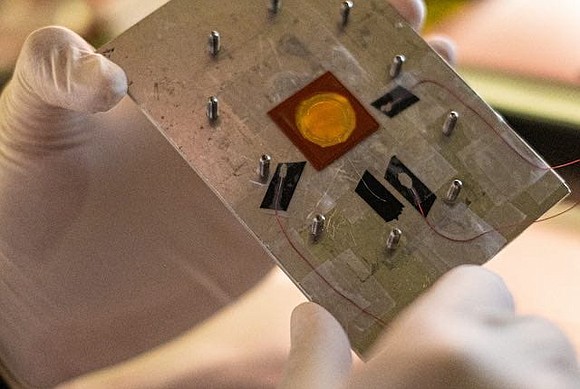Overlap allows nanoparticles to enhance light-based detection
Rice University scientists discover how plasmons amplify electroluminescence
Style Magazine Newswire | 10/14/2019, 11:52 a.m.
Rice University scientists have found revealing information where light from a molecule meets light from a nanoparticle.
The labs of Rice chemists Christy Landes and Stephan Link demonstrated how to optimize a method that can sense small concentrations of molecules by amplifying the light they emit when their spectral frequencies overlap with those of nearby plasmonic nanoparticles.
The surface plasmons, coherent electron waves that ripple across the surface of a metallic nanoparticle, act as antennas and enhance the molecules’ emitted light up to 10 times when they’re in the “sweet spot” near a particle.
Their technique is the topic of a paper in a special edition of the Journal of Chemical Physics focused on emerging directions in plasmonics. The work at Rice could help researchers analyze the active surfaces of catalysts and other materials at the nanoscale, an important step in improving their efficiency.
The discovery relies on the phenomenon of electrochemiluminescence (ECL), by which electricity drives chemical reactions that prompt molecules to emit light, said Thomas Heiderscheit, a Rice graduate student and the paper’s lead author. It is often used to detect trace materials like heavy metals in water or the Zika virus in biological fluids.
Previous studies inferred that spectral overlap of the nanoparticle and molecules would enhance the signal, but those studies could not account for the innate differences in nanoparticle sizes and shapes that could mask the effects. The Rice researchers had set out to minimize these other impacts to focus only on the role of spectral frequency overlap on signal enhancement.
“This study looks at what type of antenna is the best to use, because the properties of the nanoparticle dictate the spectrum and its overlap with the molecule,” said Miranda Gallagher, a Rice postdoctoral research associate and co-author of the paper. “Should it be round or should it have sharp edges? Should it be smaller or larger?”
In experiments, the researchers combined either gold nanospheres or sharp-tipped gold nanotriangles with a ruthenium-based dye molecule in a polymer shell that kept the molecules from migrating too far from the particles. “That’s essentially our electrode,” Heiderscheit said. “If we didn’t have the polymer, the dye molecules would be free to move and we’d see light diffused across the sample.”
With the molecules constrained by the polymer, they could clearly see molecules emitting near particles. They determined signal enhancement is controlled by a combination of size and frequency matching between the dye molecule and the nanospheres, and just frequency matching for nanotriangles.
Single-molecule imaging is still a stretch for the nascent technique, Heiderscheit said.
“Essentially, we’re imaging how active a surface is,” he said. “The Department of Energy (the main sponsor of the project) cares about this research because it could achieve super-resolution mapping of reactivity on a surface.” Super-resolution enables the capture of images below the diffraction limit of light.
“For instance, if you have nanoparticles in a battery system, you can use ECL to map where the reactions are most chemically active,” Heiderscheit said. “You’re essentially determining what nanoparticles make a good catalyst, and we can use this tool to design better ones.”
Co-authors of the paper are Rice graduate students Rashad Baiyasi, Seyyed Ali Hosseini Jebeli, Alexander Al-Zubeidi and Charlotte Flatebo; postdoctoral fellow Sean Collins and Rice alumni Leonardo Scarabelli and Wei-Shun Chang. Landes is a professor of chemistry, of electrical and computer engineering and of chemical and biomolecular engineering. Link is a professor of chemistry and of electrical and computer engineering.
The Department of Energy’s Office of Science, Basic Energy Sciences; the Robert A. Welch Foundation and Rice’s Smalley-Curl Institute supported the research.







